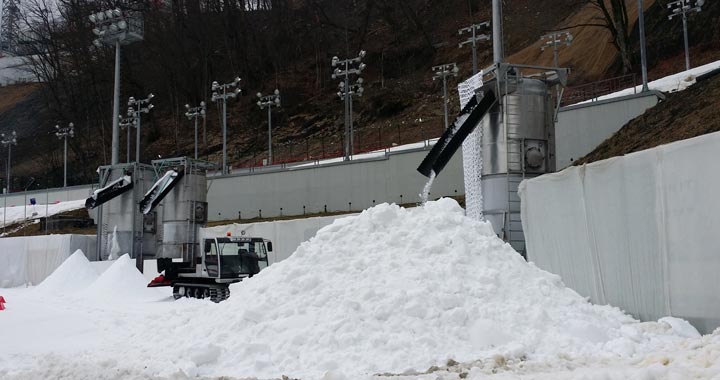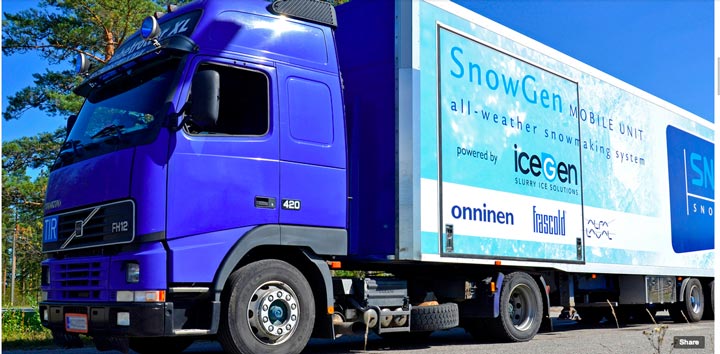TORONTO – Photos from Sochi’s Olympics look more like California postcards than the winter games. But a Canadian company hopes to save the day with its unique snow-making machinery.

Toronto-based IceGen makes “slurry ice” in what business developer David Bowden compares to a “giant margarita machine.”
They use oversized industrialized equipment containing water and refrigerated plates where ice crystals grow, producing a 50-50 mix of ice and water together.
“So you’re not making big chunks of ice and crushing it, you’re growing small crystals – the same way snow grows in nature,” Bowden said.
But because it starts as a slushy mess – think slurpees – the mixture is put into large separation towers, where ice floats to the top and water sinks down.
“At the top there’s scrapers and filters that separate the ice out and dries it a little bit further,” he said. “So you basically take out 90 per cent of the water that way, and are left with spring snow.”
The machines differ from snow cannons, often used at ski resorts, in that the cannons can only make snow at 0°C or colder. IceGen’s ice slurry makes snow that can be used at temperatures as warm as 20°C.
Which is good, because that’s where the mercury’s been sitting in Sochi lately.
Bids for snow-makers in Sochi officially began in 2011, and IceGen partnered with Finnish snow technology company SnowTek to win the contract in August 2012. SnowTek took commercial refrigerator units and made them portable, hooking them to IceGen’s “giant slushee” machines on a mobile trailer.
The result was a partnership dubbed “SnowGen” that’s now producing up to 800 cubic metres of snow a day for the ski jumping landing area and Nordic combined events. IceGen says this is equal to 15 cm covering a 5-km sidewalk.
It wasn’t easy.
There was intense demand for a robust product, Bowden said. Detailed testing happened in Bergen, Norway in August 2012, where gold medallist Olympic skiiers were brought in to test the snow IceGen made in temperatures of more than 25 degrees. The athletes approved.
The partnership allowed the company to show Olympic organizers they could provide and transport the amount of snow needed. But Bowden said it came down to executing an “emergency plan.” In a best-case scenario, none of these giant slushee machines would be needed.
“But if they need it, they’ll need it really, really badly. The equipment needs to be guaranteed to work; really robust, so you can turn on and run it 24/7.”
And in Sochi, they need it.
The equipment has been running around the clock since early January, and the recent 20-degree weather is the hottest in which IceGen has ever produced this amount of snow, said Bowden.
“I think we’re at the extreme edge of what winter conditions could be here [in Sochi],” he said. “You can’t very well cross-country ski through mud.”
Bowden said he’s “pleased” with what the machines have been able to accomplish.
IceGen started creating the “all weather snow” in 2009 after winning a bid to supply generators for the Holmenkollen and Midtstubakken ski jumps in Oslo, Norway. The company’s machines have many other applications, including fish/meat or thermal storage, supermarket displays and juice crystallization.
“One of our technicians is busy making snow in Mexico right now,” Bowden said: Citrus plants are using their machines to freeze orange juice for transport.
The company also has a Russian connection: IceGen was founded by Russian immigrant Mikhail Mogilevsky, who died last year at 65.
It’s too soon to tell whether the technology will save future Olympics. Bowden said IceGen is focused on making sure everything runs as smoothly as possible this time around, but would be happy to discuss involvement in the 2018 Winter Games in South Korea later on.
Vancouver 2010 organizers weren’t interested: “We offered – they said, ‘No, no this is Canada, there could never be a problem with snow,” Bowden said.
But in Russia, the equipment is being used even more than planned. Originally only slated to be used at ski jump and Nordic combined, the snow is now being hauled farther up the mountains on trucks to be used at the Rosa Khutor venues.
“We’re making snow … so anywhere they can use it. We’re delighted to see that,” Bowden said. “I don’t think there’s any snow in Sochi that isn’t melting right now.”




Comments